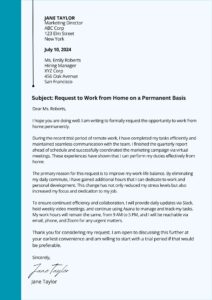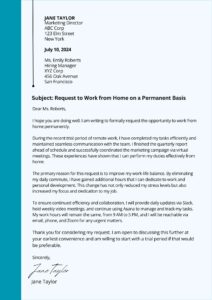Standardized requests offer numerous advantages for both employees and employers. For employees, it simplifies the process, clarifies expectations, and promotes a sense of fairness. Organizations benefit from streamlined procedures, easier tracking and management of requests, and a more transparent and equitable system for accommodating flexible work arrangements. This can lead to improved employee morale, reduced stress, enhanced work-life balance, and increased retention rates.
The following sections will delve into specific components of such a structure, offering practical guidance for crafting effective requests and implementing flexible work policies successfully.
Key Components of a Flexible Work Arrangement Request
Effective requests for modified work schedules require specific information to ensure clarity and facilitate a smooth approval process. These components allow employers to assess the feasibility of the request and its potential impact on workflow and team collaboration.
1. Employee Information: This section should clearly identify the employee making the request, including their name, department, and job title.
2. Current Work Schedule: A brief overview of the employee’s existing work schedule provides a baseline for comparison and helps illustrate the desired changes.
3. Proposed Work Schedule: This is the core of the request, detailing the specific modifications sought. It should include preferred start and end times, total hours per week, and any proposed variations like compressed workweeks or remote work days.
4. Rationale for Request: A clear explanation of the reasons behind the request strengthens its validity. This might include childcare needs, personal appointments, commuting challenges, or pursuing further education.
5. Proposed Adjustments to Maintain Productivity: Demonstrating a commitment to maintaining productivity is crucial. This might involve suggesting alternative communication methods, adjusted meeting schedules, or outlining strategies for ensuring seamless workflow.
6. Duration of Proposed Arrangement: Specifying whether the request is for a temporary or permanent change allows for appropriate planning and resource allocation.
7. Supervisor Approval: A designated space for supervisor signature signifies agreement and formalizes the arrangement.
A well-structured request facilitates open communication and fosters a collaborative approach to establishing flexible work arrangements that benefit both the employee and the organization. Providing comprehensive details ensures informed decision-making and contributes to a successful implementation.
How to Create a Flexible Work Hours Request Template
Creating a standardized template for flexible work hour requests ensures consistency, clarity, and efficiency in handling such requests within an organization. A well-designed template facilitates a structured approach, benefiting both employees seeking flexibility and management responsible for approvals and implementation.
1. Establish Clear Objectives: Define the purpose of the template and the types of flexible work arrangements it will accommodate. This clarity ensures the template meets organizational needs and employee expectations.
2. Gather Input: Consult with human resources, legal counsel, and department managers to ensure the template aligns with company policies, legal requirements, and operational needs.
3. Design a User-Friendly Format: Create a clear and concise layout using headings, subheadings, and bullet points to organize information logically. A user-friendly format simplifies the process for employees completing the request.
4. Incorporate Essential Fields: Include sections for employee information, current work schedule, proposed work schedule, rationale for the request, proposed adjustments to maintain productivity, duration of the proposed arrangement, and supervisor approval.
5. Provide Clear Instructions: Offer concise and unambiguous guidance on how to complete each section of the template. This minimizes confusion and ensures accurate information is provided.
6. Test and Refine: Pilot test the template with a small group of employees to identify any areas for improvement. Gather feedback and revise the template as needed before company-wide rollout.
7. Communicate and Train: Clearly communicate the purpose, availability, and usage of the template to all employees. Provide training on how to complete the request accurately and efficiently.
8. Regularly Review and Update: Periodically review and update the template to reflect evolving organizational needs, policy changes, and best practices. This ensures the template remains relevant and effective.
A comprehensive and well-designed template, coupled with clear communication and training, establishes a structured and equitable system for managing flexible work arrangements. This contributes to increased employee satisfaction, improved work-life balance, and enhanced organizational efficiency.
Standardized structures for requesting modified schedules offer a crucial mechanism for navigating evolving workplace dynamics. Implementing clear, accessible templates promotes transparency and consistency, benefiting both employees seeking work-life balance and organizations striving for optimal productivity. Such frameworks facilitate open communication, streamline administrative processes, and contribute to a more equitable and adaptable work environment. By providing a structured approach to requesting flexible work arrangements, organizations demonstrate a commitment to employee well-being and create a foundation for a more agile and responsive workforce.
Embracing formalized request procedures is not merely a trend but a strategic imperative for organizations seeking to attract and retain top talent. As work-life integration becomes increasingly paramount, organizations that proactively address flexible work arrangements will be better positioned to thrive in a competitive landscape. A well-defined template serves as a catalyst for fostering a more adaptable, inclusive, and ultimately more productive work environment. Organizations are encouraged to prioritize implementation and actively refine these structures to meet the evolving needs of their workforce and the demands of the modern workplace.


